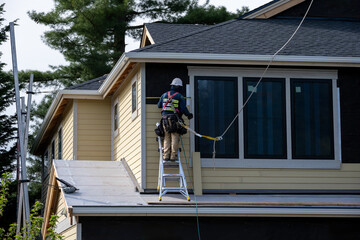When it comes to enhancing the appearance and protection of a home, siding plays one of the most important roles. Acting as both a shield and a design feature, siding improves curb appeal while guarding against weather, moisture, and structural damage. Choosing the right siding and maintaining it properly can transform an ordinary house into a beautiful, efficient, and long-lasting property.

This article explores the benefits, types, and maintenance of siding, helping you understand why it is such an essential part of any home improvement project.
Why Siding Matters for Every Home
Siding does more than give a home a fresh, attractive look. Its primary function is to protect the structure from the elements. Rain, wind, sun, and seasonal temperature changes can all damage a home’s exterior if not properly shielded. With quality siding in place, you benefit from:
- Protection from weather – Siding serves as a barrier against rain, snow, and wind, preventing water from seeping into the home.
- Improved insulation – Many siding materials provide additional energy efficiency, keeping homes cooler in summer and warmer in winter.
- Curb appeal – A home’s exterior is the first thing people notice, and well-chosen siding can significantly increase property value.
- Durability – With the right siding, homes are more resistant to pests, rot, and impact damage.
Popular Types of Siding
There is no one-size-fits-all solution for siding. The best choice depends on factors such as climate, budget, design preferences, and maintenance requirements. Here are some of the most common siding options homeowners consider:
1. Vinyl Siding
Vinyl siding is a popular choice thanks to its affordability and low maintenance. It comes in a wide variety of colors and styles, making it versatile for different home designs. Vinyl is also resistant to rot and pests, though it may not be as durable as other materials in extreme weather.
2. Wood Siding
Wood siding offers a classic and timeless look. Available in shingles, shakes, or panels, wood gives homes a natural charm and warmth. However, it requires regular maintenance, including painting or staining, to prevent rot and insect damage.
3. Fiber Cement Siding
Fiber cement siding is known for its durability and ability to mimic the look of wood, stone, or brick. It resists fire, pests, and rot while offering long-lasting performance. Though it may come at a higher cost, many homeowners appreciate its strength and appearance.
4. Metal Siding
Aluminum and steel siding are strong, durable, and resistant to many types of damage. They are often used for modern or industrial-style homes and require minimal maintenance. Metal siding is also recyclable, making it an eco-friendly option.
5. Brick and Stone Veneer
While not technically siding in the traditional sense, brick and stone veneers provide an attractive, durable exterior. They offer a premium look and strong protection against the elements, though installation costs can be higher.
Key Benefits of Installing New Siding
Upgrading or replacing siding provides several advantages beyond just appearance. Some of the top benefits include:
- Energy efficiency – Many modern siding options come with insulation that reduces energy loss.
- Increased home value – A well-maintained exterior boosts curb appeal, making the property more attractive to potential buyers.
- Low maintenance – Depending on the material, siding can drastically reduce the time and cost of exterior upkeep.
- Enhanced durability – New siding strengthens your home’s defense against moisture, pests, and weather extremes.
Maintenance Tips for Long-Lasting Siding
Even the most durable siding requires proper care to maximize its lifespan. Here are some maintenance tips:
- Regular cleaning – Wash siding at least once a year to remove dirt, mildew, and stains.
- Inspect for damage – Look for cracks, warping, or loose panels that may allow moisture to enter.
- Repaint or reseal – Wood siding and some fiber cement types may need painting or sealing every few years.
- Clear surroundings – Trim trees, bushes, and plants that touch the siding to prevent scratches and moisture buildup.
- Check caulking – Seal gaps around windows and doors to ensure no water seeps behind the siding.
Routine maintenance not only improves appearance but also prevents costly repairs.
How to Choose the Right Siding for Your Home
Selecting the best siding requires balancing aesthetics, performance, and budget. Consider the following factors:
- Climate – Choose siding that withstands the specific weather conditions in your region.
- Style – Match siding colors and textures with your home’s architectural design.
- Maintenance level – Decide how much time you want to spend on upkeep.
- Longevity – Some materials last decades longer than others, making them a smart investment.
- Cost – While some siding options may seem expensive upfront, they often provide long-term savings in energy efficiency and durability.
Signs It’s Time to Replace Your Siding
Not sure if your siding needs replacing? Look for these common warning signs:
- Cracks, warping, or buckling panels.
- Mold, mildew, or rot on the surface.
- Fading color or peeling paint.
- Higher energy bills due to poor insulation.
- Frequent repairs are needed to maintain the appearance.
If you notice these issues, investing in new siding can save money in the long run while giving your home a fresh new look.
Siding is one of the most important elements of a home’s exterior, providing both beauty and protection. With so many styles and materials available, homeowners can choose the option that best fits their needs, budget, and design preferences. From vinyl and wood to fiber cement and metal, each type of siding offers unique benefits.
By investing in quality siding and keeping it well-maintained, you can improve energy efficiency, increase property value, and enjoy a home exterior that stands the test of time. Whether you’re building new, renovating, or replacing old siding, the right choice will make your home more durable, attractive, and inviting for years to come.